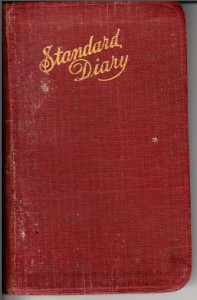 If your family is anything like mine, you heard plenty of stories about your great-grandparents from your parents. From those stories I have been able to get a sense of their personalities and how they lived, but it is a view limited to how my parents knew them as their grandparents. Learning who your ancestors were as young adults is difficult, since most standard documents do not reveal an individual’s personality. My mother has a genealogical file on each of my relatives, where she keeps news clippings or other documents pertaining to their lives, which I often refer to while I am researching my family. During my last visit home, while searching through her files, I discovered the diary of my great-grandmother, Gladys Tompkins, from the year 1924.
If your family is anything like mine, you heard plenty of stories about your great-grandparents from your parents. From those stories I have been able to get a sense of their personalities and how they lived, but it is a view limited to how my parents knew them as their grandparents. Learning who your ancestors were as young adults is difficult, since most standard documents do not reveal an individual’s personality. My mother has a genealogical file on each of my relatives, where she keeps news clippings or other documents pertaining to their lives, which I often refer to while I am researching my family. During my last visit home, while searching through her files, I discovered the diary of my great-grandmother, Gladys Tompkins, from the year 1924.
Diaries such as this one, which have just small spaces to write in each day, provide a window into the diarist’s important activities, since there is not enough space to write about much more. Many of Gladys’ daily entries were limited to “we washed today” or “we did not do much today.” Short as they are, her entries reveal much about the cycle of social life in rural New York. Many of her entries in the winter note that she felt lonesome, while the entries in the spring and summer are filled with visits and dances. Her entry for Monday, 11 February 1924, reads “We washed today. It is quite cold. Am sleepy and lonesome. Wish it were June. Haha.” These are moments where her personality shines through, providing a glimpse of who she was and how she felt at the age of twenty.
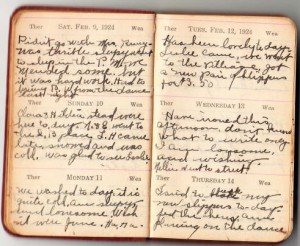 Her entries also provide important information about her friends and relatives, as she mentions her visitors. I was especially excited to find this diary, because 1924 was the year that my great-grandparents Gladys Tompkins and Leslie Holdridge were married. I had hoped the diary would chronicle their engagement and the preparations for their wedding, but the only indication of their relationship was a number of entries noting “L.H. came today” or “I hope Leslie visits.” On 18 October, the day of their wedding, the entry was simple. She even started the entry with “we finished packing today,” followed by “Leslie and I went to Prattsville this P.M. We were married there in the M.E. Church.” She also noted that Charlie and Olive accompanied them, but there is little other information about the wedding, suggesting that it was small and intimate.
Her entries also provide important information about her friends and relatives, as she mentions her visitors. I was especially excited to find this diary, because 1924 was the year that my great-grandparents Gladys Tompkins and Leslie Holdridge were married. I had hoped the diary would chronicle their engagement and the preparations for their wedding, but the only indication of their relationship was a number of entries noting “L.H. came today” or “I hope Leslie visits.” On 18 October, the day of their wedding, the entry was simple. She even started the entry with “we finished packing today,” followed by “Leslie and I went to Prattsville this P.M. We were married there in the M.E. Church.” She also noted that Charlie and Olive accompanied them, but there is little other information about the wedding, suggesting that it was small and intimate.
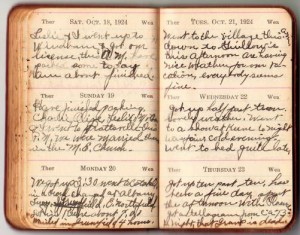 While I was fascinated reading about my great-grandmother’s daily life in 1924 and her budding relationship with my great-grandfather, I knew that the best genealogical information was likely to be in the back of the book, where there are spaces for addresses and notes. There was one page that recorded all the letters she received that year and when she replied. This information is valuable, since you cannot always discern who individuals were closely associated with by looking at vital and census records alone. Gladys also recorded her grandmother’s birthdate and age in 1924, as well as the birthdates of some of her friends.
While I was fascinated reading about my great-grandmother’s daily life in 1924 and her budding relationship with my great-grandfather, I knew that the best genealogical information was likely to be in the back of the book, where there are spaces for addresses and notes. There was one page that recorded all the letters she received that year and when she replied. This information is valuable, since you cannot always discern who individuals were closely associated with by looking at vital and census records alone. Gladys also recorded her grandmother’s birthdate and age in 1924, as well as the birthdates of some of her friends.
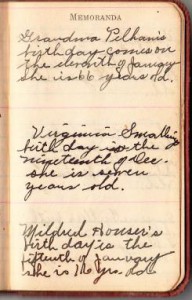 Perhaps the most intriguing and unexpected page in the back was a list of names entitled “attended our horning.” Having never heard of a “horning” before, a little research revealed that it was a wedding ritual where friends of the bride and groom would blow horns outside the couple’s bedroom window on their wedding night. According to Nancy Grey Osterud, author of Bonds of Community: The Lives of Farm Women in Nineteenth-Century New York, a horning ritual was just as important to most couples as their wedding ceremony and they would have been sorely disappointed if they did not receive one. In contrast to their small and quiet ceremony, the horning was a rowdy and fun-loving affair, and it was clearly important enough to Gladys for her to record all the names of those in attendance.
Perhaps the most intriguing and unexpected page in the back was a list of names entitled “attended our horning.” Having never heard of a “horning” before, a little research revealed that it was a wedding ritual where friends of the bride and groom would blow horns outside the couple’s bedroom window on their wedding night. According to Nancy Grey Osterud, author of Bonds of Community: The Lives of Farm Women in Nineteenth-Century New York, a horning ritual was just as important to most couples as their wedding ceremony and they would have been sorely disappointed if they did not receive one. In contrast to their small and quiet ceremony, the horning was a rowdy and fun-loving affair, and it was clearly important enough to Gladys for her to record all the names of those in attendance.
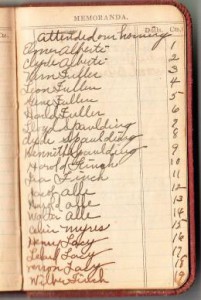 If you are lucky enough to come across daily journals of your ancestors while researching your family, you may be surprised at how much information you can gather from a few sentences recorded each day. Always be sure to check the pages hidden in the back, as they may contain names, birthdates, and anniversaries, or maybe even references to a horning.
If you are lucky enough to come across daily journals of your ancestors while researching your family, you may be surprised at how much information you can gather from a few sentences recorded each day. Always be sure to check the pages hidden in the back, as they may contain names, birthdates, and anniversaries, or maybe even references to a horning.
That diary sounds very similar to my grandmother’s…..but from it I learned that she used to do some cooking or baking about every day, which surprised me because I never knew her to be much of a cook! It does change your perception of them.
I’m lucky enouth to have my grandmother’s diaries from 1903 through 1906. There are a lot of “I got up at the usual time today.” entries, but I could follow where she worked, when she took her sister to the TB Sanitarium at Saranac Lake, NY, how she met my grandfather, when she got engaged and married, who she wrote to, and lot of other things. I also have her autograph book from an earlier time, letters from her brothers, and some old, old pictures. She died at age 75, when I was 9 years old, but she was one of my favorite people, and you’re right–it’s fun to learn about a person when she was young.
Meaghan,
Your recalling the finding of your gr-grandmother’s diary brought back some good memories. While cleaning out my mom’s apartment after she passed away I came upon several small journals that she had written daily notes in much like your gr-grandmother. Her journals covered the last seven (7) years of her life from age 79 to 86. We never knew they existed. They were also filled with short every day observations. Some were funny, sad, uplifting, serious and conveyed all the emotions you might expect. Her last entry contained just the date and a short line. It was the day she was taken to the hospital for the last time. They also, as you indicated, let you see mom’s personality, wit and when needed a caustic remark or two but nothing too derogatory. Mom always spoke her mind and if she didn’t like you she wasn’t bashful about telling you fairly promptly. She was born and spent her whole life in Vermont and in her later years really hated the cold and winters snow. One entry simply stated, “It snowed today. It’s very cold and windy. I HATE SNOW!!!” Thanks for bringing back very fond memories.
I am very lucky to have a box of letters that my grandparents wrote to each other during the 1920s-1940s. My grandfather was in the Navy and she was home raising four young boys, and later a total of 10 children. It is wonderful to get a glimpse of her life as a young mother, and later a more mature woman. I always admired my grandmothers strength, and I can see where it came from.
Thanks for this, Meaghan. I recently received a box of old family letters — a complete mess with letters to/from different people in different generations and different decades. Among the jumble was my grandmother’s date book. I put it aside without delving too deeply but you have inspired me to pull it out. I know I will look at it differently, keeping in mind your discoveries.
Horning: see “Shivaree”–a relatively widespread custom.
Thanks, Meaghan. You wrote it beautifully. Grandma would be proud.
My great-grandmother kept THREE such diaries–simultaneously. She paid no attention to the dates when she made her entries, and often recorded the same entry in 2 or 3 diaries, each one containing a different tidbit about the event being recorded. She was especially detailed in recording how much she (or anyone else in her circle) paid for goods and services. I am working on transcribing and consolidating the information in her diaries, putting events in chronological order, to get a fuller picture of her life.
My maternal grandmother (1900 – 1984) was a Chicago girl, a Swede from the Andersonville neighborhood. I have her Standard Diaries from 1919 to 1922; they are identical to your great grandmother’s! Much interesting information in them; she worked downtown as a secretary at one of the railroads. Fun reading!
I wish I had kept a diary, so I could look back now and see whether the entries reveal that I was the person I imagine myself to have been!
I have the diary, as you describe, with short entries for each day, of my paternal grandmother for 1910-1911. This is especially valuable to me as she died before I was born. She kept it during the year she was engaged, though she’d known the man for years before the engagement. While they lived in the same town, he worked as a civil engineer, mostly out of town. She was the oldest of 7 children, and the diary is full of the chores, jobs, university classes, and the family’s sense of themselves as important citizens of their small town, where their father owned a mercantile store that the girls worked in to help out, and to earn a bit toward their own educations. The family were Methodists, and church was very important to them. They were a little on the strict side, but very fun loving. Often the house would be full of young people gathered around my grandmother at the piano, singing and drinking cocoa. I’ve also got 300+ post cards my grandparents wrote to each other during this period, one long love letter he wrote her (much more intimate than the post cards!), and several photo albums. All these give me a fairly well-rounded picture of a couple I wish I’d known in person. I did know all her siblings, but as middle aged and old people (one lived to 101). The diary gives me, as you note, a picture of them as young people. Another thing I love about it is that my father transcribed it and annotated it with who some of the friends and neighbors were whom he knew.